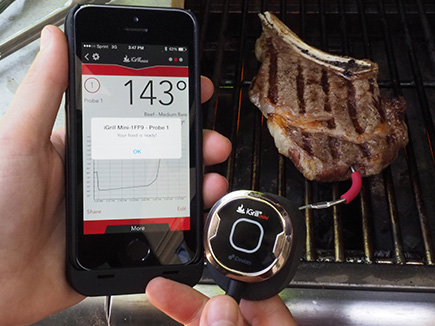Tom's Guide Verdict
The iGrill mini provides an inexpensive way to take the guesswork out of cooking meat.
Pros
- +
Small
- +
Easy setup
- +
Long temperature probe
Cons
- -
Only one temperature probe port
Why you can trust Tom's Guide
How would you like your steak done? Rare? Medium rare? One of the trickiest aspects of cooking is making sure meat is done to the right temperature. Take your cut off the heat too soon, and your guests get a bloody, raw mess. Take it off too late, and they get dry shoe leather. The iGrill Mini ($39) helps take the guesswork out by alerting you when the meat is ready to come off the grill or stove.
Editor's Note: Since our initial review, Weber purchased iGrill, so the product images of the iGrill in this review may not necessarily reflect the current device. However, the functionality remains the same. In addition, there is now an Android version of the app.
Design
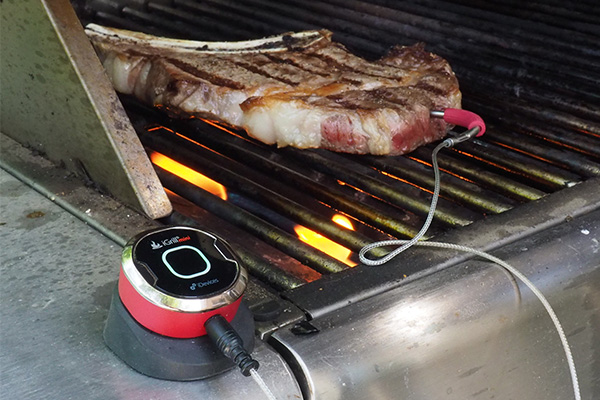
The small and squarish iGrill mini is about the size of a large ice cube, measuring 2 x 1.75 x 1.5 inches and weighing 1.4 ounces. The top of the gadget is a glossy black trimmed with chrome, and the sides are a burgundy red. The bottom of the iGrill mini is magnetized, so it will remain securely attached to your grill or stove. The device's small size made it easy to stash in a kitchen drawer, where it quickly became lost amid all my other utensils.
While it's designed to work with your smartphone, the iGrill mini also has a circular LED on the top that changes from green to yellow to orange-red to let you know how close your food is to the desired temperature. It's a smart and simple visual cue.
The detachable probe, which is at the end of a 4-foot long cord, will work from -22 degrees Fahrenheit up to 572 degrees. The iGrill mini has a Bluetooth range of about 150 feet, and its coin cell battery will last about 150 hours before you need to be replace it.
MORE: Amazing Smart Home Gadgets
App
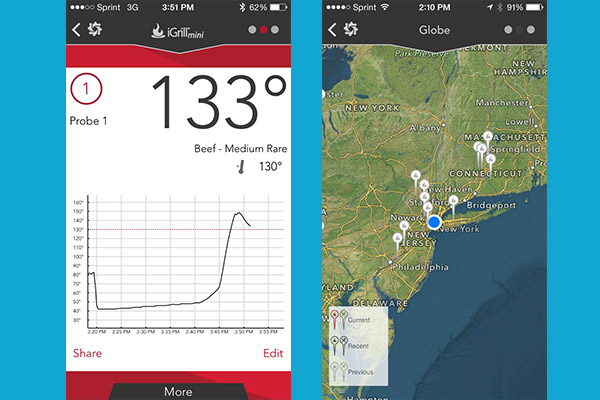
The iGrill mini will connect to iOS and Android devices.
The app connected quickly to the iGrill mini, which began relaying temperature information continuously to the app.When connected, the main section of the screen shows the temperature as recorded by the iGrill mini, as well as a graph plotting the temperature over time. If the iGrill mini isn't connected, this area is grayed out.
At the bottom of the app is a More tab that reveals several menu options when pressed, including Globe, Share, Recipes, Timers, Shop Products and Support. Globe opens to show a map with pins; selecting a pin reveals a picture an iGrill user took and tagged with #iGrill. It's a neat little addition that shows you what others are making.
Performance
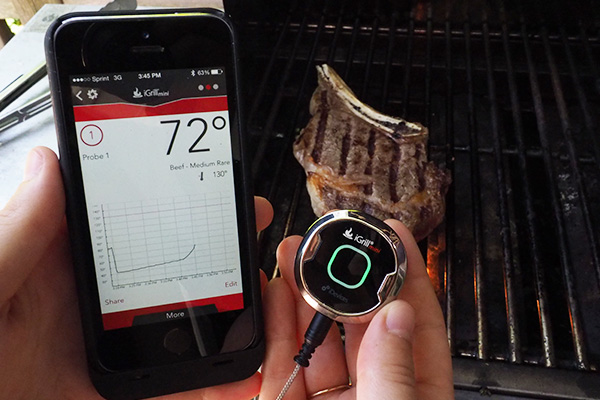
The iGrill Mini's thermometer proved very accurate; we compared its results to those of a digital thermometer, and found that both registered a pot of boiling water correctly at 212 degrees Fahrenheit.
We then used the iGrill mini while cooking a roast chicken in the oven and a steak on the grill. We inserted the iGrill's probe into the thigh of the chicken, and let it cook at 350 degrees. The metal wire leading from the probe to the iGrill Mini was long enough so that we could snake it out of our oven, and thin enough so that the oven door still shut securely.
On our iPhone 5s, we selected as the preset. After a few hours, the app rang and alerted us that the chicken had reached the correct temperature.
The iGrill also worked well with a steak on the grill, alerting us when the meat had reached 130 degrees, the temperature for a medium-rare steak. It was surprising to see how quickly the temperature rose inside the steak. The one thing that the iGrill mini can't do, though, is tell you when to flip a steak over.
MORE: Best Soundbar
Bottom Line
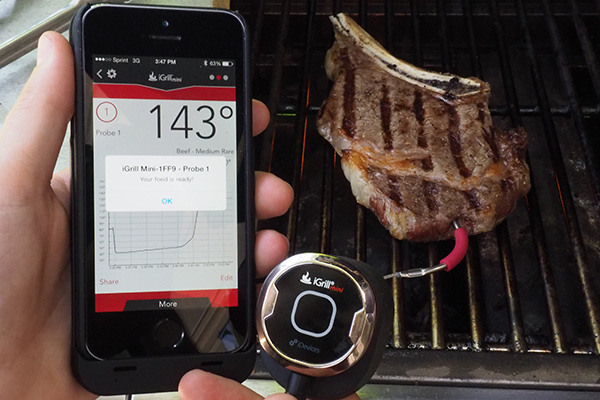
For $28, the iGrill mini will offer some comfort to novice home cooks, or a solution for those who want to go watch the game while getting dinner ready. It's not foolproof, but for those who want to make sure they don't ruin the main course, the iGrill mini works well both indoors and out.

Michael A. Prospero is the U.S. Editor-in-Chief for Tom’s Guide. He oversees all evergreen content and oversees the Homes, Smart Home, and Fitness/Wearables categories for the site. In his spare time, he also tests out the latest drones, electric scooters, and smart home gadgets, such as video doorbells. Before his tenure at Tom's Guide, he was the Reviews Editor for Laptop Magazine, a reporter at Fast Company, the Times of Trenton, and, many eons back, an intern at George magazine. He received his undergraduate degree from Boston College, where he worked on the campus newspaper The Heights, and then attended the Columbia University school of Journalism. When he’s not testing out the latest running watch, electric scooter, or skiing or training for a marathon, he’s probably using the latest sous vide machine, smoker, or pizza oven, to the delight — or chagrin — of his family.
